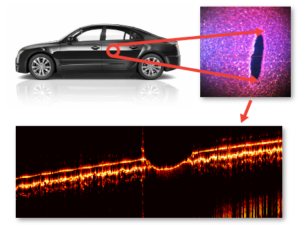GRATINGS +1 435.752.4301 SPECTROMETERS +1 919.544.7785 OCT +1 919.544.7785
GRATINGS +1 435.752.4301 SPECTROMETERS +1 919.544.7785 OCT +1 919.544.7785
OCT uses infrared light to provide surface profiles and information about subsurface structure and uniformity, delivering higher resolution and faster images than ultrasound inspection for non-destructive testing. This novel technology for NDT requires no contact or coupling medium, yet delivers accurate information in real time for in-situ process feedback and high-throughput quality control on finished parts.

 Manufacturing
ManufacturingOCT is an excellent tool for evaluation of shapes and dimensions of tools, molds, and final parts, as shown here for polymer-based 3D printing. It can also provide real-time process feedback for control of ablation depth during laser machining, and for defect detection and dimensional analysis in additive manufacturing.
 Aviation and Automotive
Aviation and AutomotiveOCT can be used to evaluate application of critical coatings and paints in industries like aviation and automotive. High resolution layer imaging enables analysis of thickness uniformity and defects that can impact quality and safety, as shown in this detailed image of a multilayer paint coating.
 Displays and Panels
Displays and PanelsThe excellent axial resolution of OCT is ideal for NDT imaging of the multilayered structures used in display panels. The 3D information acquired can be used to evaluate flatness uniformity and identify subsurface defects affecting display quality. Sublayers < 10 µm in thickness can be clearly imaged, as shown here.
 Medical Devices
Medical DevicesThe medical industry has been quick to adopt OCT for the analysis of high precision medical devices due to its ability to generate non-contact images of very small, thin, and delicate structures such as this contact lens. OCT can also provides information about pores, defects, and gaps in the production of critical membranes and seals.
Take QA and process monitoring to the next level with non-contact OCT imaging at micro-level resolution for accurate, quantitative analysis of features and defects. Capture 3D images in under a minute or rapid cross sections for real-time process control feedback. Starting with our own, high wavelength resolution spectrometer design, you can create an OCT system with industry-leading depth penetration and resolution. We also develop custom solutions for specific OEM and manufacturing applications, from spectrometers to sub-systems. Our OCT spectrometers can be controlled through our software development kits to speed your development and begin taking images quickly.
 While ultrasonic inspection has become the standard in subsurface imaging, it is limited in its speed, resolution, and ability to probe small or irregular samples. Confocal imaging provides submicron resolution, but is very expensive, and limited to depths of less than 1 mm.
While ultrasonic inspection has become the standard in subsurface imaging, it is limited in its speed, resolution, and ability to probe small or irregular samples. Confocal imaging provides submicron resolution, but is very expensive, and limited to depths of less than 1 mm.
OCT is a novel yet well-established technology that provides intermediate imaging depth at both high resolution and speed. It retains ultrasound’s flexibility in taking the probe to the sample, while eliminating the need for coupling media. It easily measures small or thin parts, delicate samples, and rough surfaces, making it ideal for non-destructive testing.